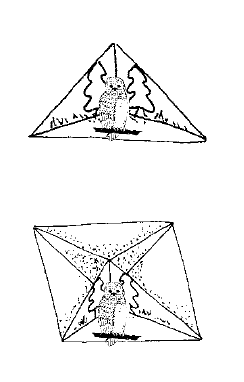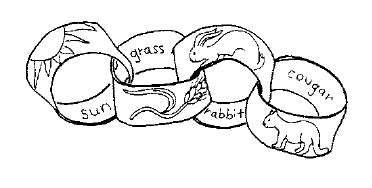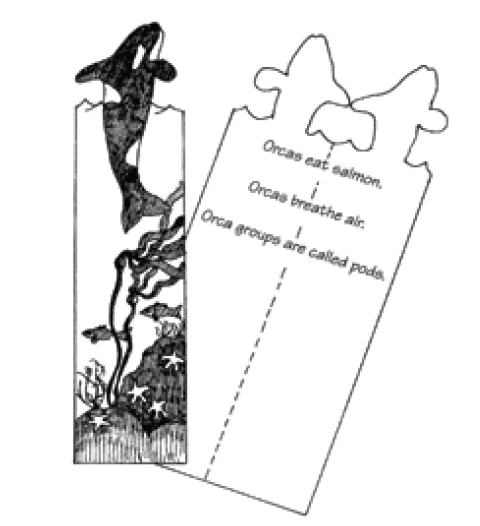One way that students can communicate what they know about a topic is to show an audience what they have learned. The three projects listed below are just some of the many ways that students can provide teachers with insight into their learning.
HABITAT (example: the Spotted Owl)
 This project could be used to summarize habitat information as the study of any animal is completed. It could also be used as the concluding activity for a study of a region of Canada (e.g., tide pool, tundra, grasslands, cedar forest, etc.)
This project could be used to summarize habitat information as the study of any animal is completed. It could also be used as the concluding activity for a study of a region of Canada (e.g., tide pool, tundra, grasslands, cedar forest, etc.)
Materials
- construction paper squares (23 cm x 23 cm)
- construction paper scraps of different colours
- found objects suitable for model making (leaves, shells, etc.)
- glue, scissors, crayons, felts pens, pencils
- modeling clay (e.g., Plasticine)
Process
1. Look close closely at some pictures of the spotted owl. Take special note of its habitat. Have the students pay attention to body proportions.
2. Review the basic needs of an animal to ensure its survival (water, air, food, shelter).
3. Fold the construction paper squares in half on the diagonal. Open and fold on the other diagonal.
4. Lay flat and cut from one corner to the center.
 5. Use scraps of construction paper or crayons to create a forest scene on the top half of the paper (the cut line dissects the bottom half).
5. Use scraps of construction paper or crayons to create a forest scene on the top half of the paper (the cut line dissects the bottom half).
6. Overlap the two bottom triangles and glue them together.
7. Make a model of an owl using modeling clay.
8. Place the owl on the model and add items that complete the habitat, including moss, twigs, etc.
Other Ideas
If you want to compare habitats of various animals, or compare different geographical regions, you could make four of these models and fit them together to make a four-sided display.
PAPER CHAINS (example: food chains)
Each segment of a chain can represent an important part of a whole idea or concept. Food chains, life cycles, story plot lines, timelines, attributes of a story character and many other topics can easily be visualized in this way. The chains can be hung next to other displays about the topic, hung as mobiles, or linked together with other chains to hang around the classroom.
Materials
- paper strips
- crayons, felt pens or pencil crayons
- glue
- scissors
Process
1. Discuss food chains with your students and emphasize the important role of each member of the chain. Choose one animal and establish the links in the food chain on both sides of the animal.
2. Brainstorm things that can influence the food chain such as destruction of habitat, extinction of particular food chain members, poisons in the water supply, etc.
3. Introduce the terms:
• herbivore: an animal that feeds on plants
• carnivore: an animal that feeds on animals
• omnivore: an animal that feeds on both plants and animals
4. Discuss how poisons can travel up the food chain and become concentrated in animals at the top of the chain.
5. Have the students choose an animal and make chains from paper strips to represent a food chain that includes that animal. Information about each link in the chain can be written or drawn on paper strips and then glued or stapled together. Challenge the students to make food chains as long as they can.
 Other Chain Ideas
Other Chain Ideas
Life Cycles, e.g., Frogs: tadpole, tadpole with legs, froglet, adult frog.
Attributes, e.g., Birds: birds have feathers, they hatch from eggs, they build nests, birds fly.
BOOK MARKS (example: Orca attributes)
This project can be a lot of fun for students to create after reading a book or at the end of a thematic unit. The folding bookmark can be decorated on the front and the space inside used for recording facts, vocabulary, timelines, connections, summaries, etc.
Materials
- pencil
- scissors
- crayons, pencil crayons or felt pens
- construction paper strips
Process
1. Fold the paper in half.
2. Design and colour the illustration.
3. Print the title of the book or unit of study.
4. Print the information on the inside.

ABOUT THE AUTHOR
Brenda Boreham
Brenda is the Literacy Resource Teacher at her school. This part-time position allows her to plan fun literacy events when she isn’t busy in her own classroom.
This article is from Canadian Teacher Magazine’s January 2010 issue.











